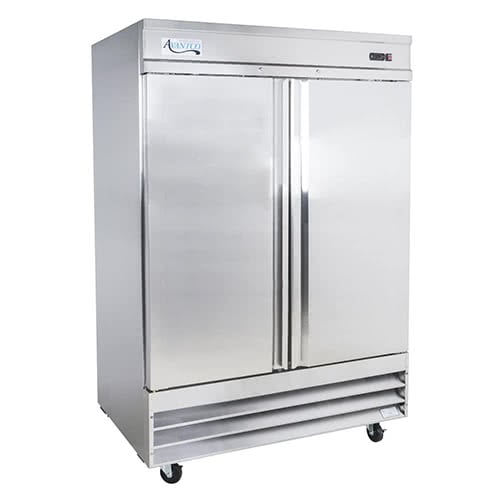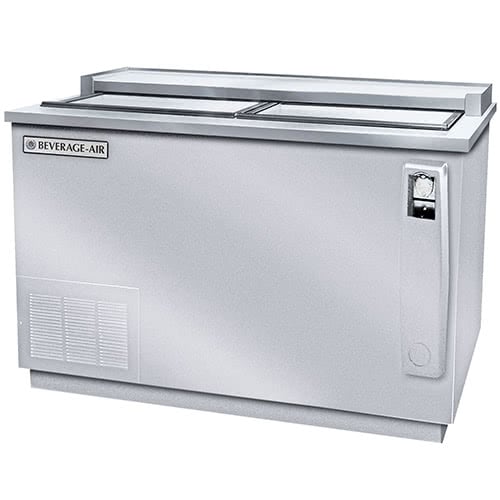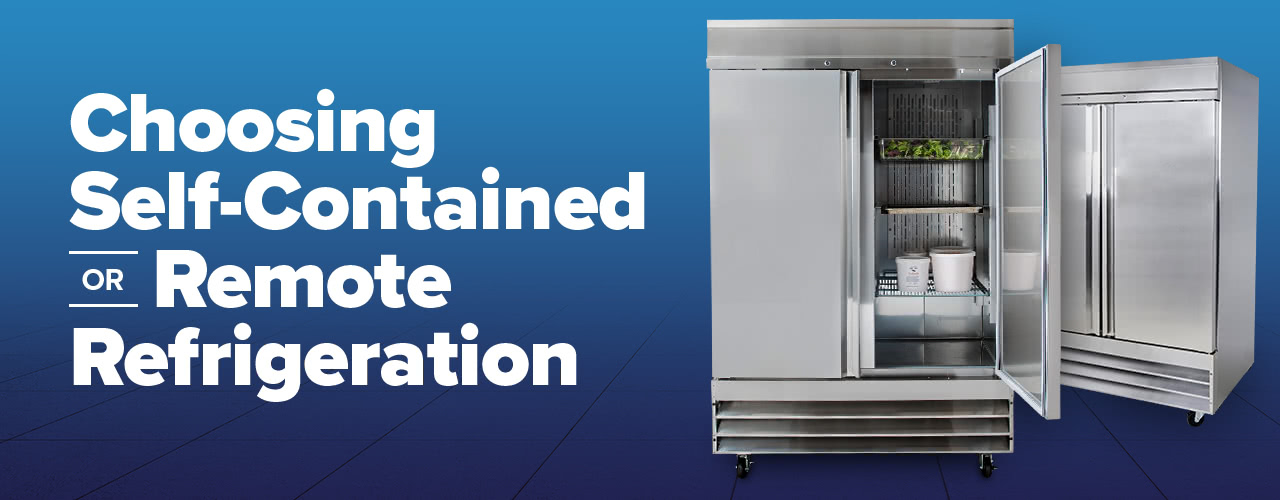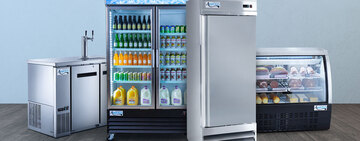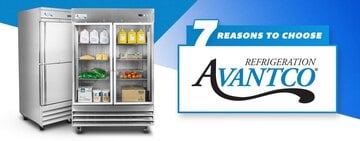Every chef or restaurateur has experienced the frustration of food spoilage. Knowing how to store produce will reduce food waste, maximize your restaurant's profits, and improve your menu’s flavor quality. We lay the foundational knowledge you need to organize your commercial refrigerator/storeroom, explain fruit and vegetable storage, and provide an itemized produce storage chart.
Looking for a food storage temperature chart? Click the link below to jump ahead and view our item specific produce storage chart.
How to Store Fruits and Vegetables Chart
Best Way to Store Produce
Saying there is one way to store fresh produce is a bit like saying there is one way to make a pizza. However, there are universal best practices for organizing your restaurant’s storeroom.
Store produce at reduced temperatures to increase its shelf life.
Don't stack produce. Pressure and lack of airflow shorten fresh produce’s lifespan.
Keep produce unwashed in storage. When you’re ready to use your fresh items, make sure you wash your produce properly.
Don't cut produce until you're ready to use it. Cut produce is vulnerable to microorganisms.
Store your fresh produce where there is some airflow (not in airtight containers or bags). This prevents them from suffocating and spoiling faster.
Don't buy fresh produce too far in advance. Produce loses its flavor and crispness when held at low temperatures for extended time periods.
What Is Ethylene?
Ethylene is a plant hormone that makes seeds/buds sprout, ripens fruit, and causes plant cells to break down. Plants release ethylene as a gas.
Understanding ethylene helps you extend the shelf life of your fruits and vegetables. The first thing you need to know is plants’ ethylene productions and sensitivities are not universal. So, you should store ethylene producers separate from ethylene-sensitive items.
Savvy commercial kitchen operators manipulate ethylene to accelerate ripening. All you need to do is place a high ethylene producing fruit inside a paper bag with the item you want to ripen. The paper bag traps the ethylene gas, yielding ready-to-eat fruit faster.
Climacteric Fruit Definition
The term 'climacteric' is used to describe fruits that continue to ripen after they're picked. Climacteric fruits create and release far more ethylene than non-climacteric fruits. As you may have guessed, the term 'non-climacteric' describes fruits that don't ripen once they're picked.
Top Ethylene Producing Fruits
These common climacteric fruits are some of the top ethylene producers. Their ethylene potency increases as they ripen.
Apples
Avocados
Bananas
Cantaloupe
Peaches
Pears
As an easy-to-reference resource, we've created a downloadable produce storage chart you can keep in your commercial kitchen.
Download our Ethylene Production and Sensitivity PDF
Fruit and Vegetable Storage
It’s best to store your fruits and vegetables separately. Most fruits release a lot of ethylene, and most vegetables are sensitive to it. Learn how to store vegetables and fruits to meet each category’s unique needs.
How to Store Vegetables
On average, vegetables contain nonexistent traces of ethylene compared to fruits. Learn how to maximize the freshness and quality of the most popular vegetables below.
How to Store Tomatoes:
Keep tomatoes in your storeroom away from sunlight. Tomatoes will not ripen correctly in the refrigerator. Arrange them stem side down until they're fully ripe. Tomatoes keep best when they aren’t touching, so store them in a single layer. Do not bunch them together. Once the tomatoes are soft and vibrant, prolong their shelf life by transferring them to the fridge.
Best Way to Store Potatoes:
Store potatoes outside the fridge in a cool, dark, dry spot. Refrigerated air is too cold for potatoes and causes their starch to turn to sugar. Store potatoes in a paper bag, basket, or large bowl. Don't store potatoes in plastic bags/sealed containers that trap moisture. Damp environments cause potatoes to spoil faster.
How to Store Cucumbers:
To keep cucumbers fresh, wrap clean and dry cucumbers in a paper towel and place them inside a plastic bag. The plastic bag helps protect the cucumbers from ethylene gas. Leave the top of the bag open to provide airflow and help prevent molding and sogginess. Use this same method to store celery and spinach.
How to Store Carrots:
The first step in carrot storage is trimming their leafy tops. Carrot tops extract moisture from their roots, causing them to wilt prematurely. Keep your carrots hydrated by storing them in an uncovered container of shallow water inside your fridge. If space doesn't accommodate this method, your next best option is to store carrots in an open plastic bag.
How to Store Fruit
Learn how to store fruit to achieve complete ripeness and long shelf lives. While most fruits are ethylene producers, not all fruits release the same amount of ethylene, nor are they equally sensitive to it. Below are our tips for turning the most popular fruits into ripe and unspoiled ingredients.
How to Keep Bananas Fresh:
Keep bananas fresh by buying slightly green bananas and storing them at room temperature until they’re ripe. You can keep fully ripe bananas in the fridge to prolong their shelf life. Bananas will overripen in the refrigerator, but they will remain perfectly edible despite their mushy textures and blackened peels. There are many ways to repurpose overripe produce. For example, super sweet, overripe bananas are ideal for baking.
To quickly ripen bananas, store them in an enclosed space such as a sealed container or bag. Bananas are high ethylene producers, so enclosing them with their ethylene creates a ripening sauna.
How to Store Grapes:
Store grapes in the plastic container you purchased them in at cold temperatures. Grapes need ventilation, which is why their original grocery store plastic packaging has holes. However, ventilation and direct air are two different things. Keep grapes out of your refrigeration systems’ direct air path, or they will dehydrate and shrivel.
Grapes mold when stored moist, so wait to wash your grapes until you’re ready to consume/cook them. Grapes absorb the odors and flavors around them, so keep onions away.
How to Store Avocado:
You need to store avocados in a way that promotes ripening, because avocadoes don't ripen until they're picked. Avocados won't ripen correctly at low temperatures. They are high ethylene producers, so keep them away from ethylene-sensitive produce. Like bananas, you can expedite avocados’ ripening process by storing them in a paper bag.
How to Store Fruits and Vegetables Chart
Enliven your restaurant’s menu by incorporating fresh regional produce each season without losing profits to food spoilage with our fruit and vegetable storage chart.
Produce Type
Ideal Storage Temperature
Ethylene Production
Ethylene Sensitivity
Storage Life
Apples30-35 °FHighYes8 weeks
Apricots31-32 °FHighYes1-3 weeks
Artichokes34-38 °FNoNo5-7 days
Asparagus32-35 °FNoYes2-3 weeks
Avocados, ripe41-55 °FHighYes3 days
Avocados, unripe36-40 °FLowYes (High)4-5 five days until ripe
Bananas, green59-68 °FLowYes 3-4 days until ripe
Bananas, ripe56-58 °FMediumNo3-7 days
Basil51-59 °FNoYes1-2 weeks
Beans, green or snap41-45 °FNoYes7-10 days
Beans, sprouts32 °FLowYes (Low)7-9 days
Beets32-40 °FNoYes10-14 days = bunched 1-3 months = topped
Blackberries31-32 °FVery LowNo3-6 days
Blueberries33-34 °FVery LowNo1-2 weeks
Bok Choy32-35 °FNoYes3-4 days
Broccoli32 °FNoYes21-28 days
Brussels Sprouts32 °FVery LowYes3-5 weeks
Cabbages32 °FNoYes (High)Early cabbages = 3-6 weeks Late cabbages = 5-6 months
Cantaloupe36-41 °FYesYes12-15 days
Carrots32 °FVery LowYes (High)10-14 days = bunched 7-9 months = mature roots 3-4 weeks = fresh cut
Cauliflower32 °FNoYes (High) 4 weeks
Celery32 °FNoYes (High)2-3 months
Cherries30-32 °FVery LowNo4-10 days
Chicory32-35 °FNoNo3-5 days
Coconuts32-25 °FNoNo2-3 weeks
Collards32-36 °FNoYes5-7 days
Corn, sweet32-34 °FNoNo5-7 days
Cranberries36-40 °FNoNo2-4 months
Cucumbers50-55 °FVery LowYes10-14 days
Currants34 °FLowYes (Low)1-2 weeks
Eggplant50-54 °FNoYes (High)14 days
Figs30-32 °FLowYes5-7 days
Fresh, Whole Garlic30-32 °FNoNo3-6 months
Ginger Root54-57 °FNoNo4-6 weeks
Grapefruit55-60 °FVery LowNo6 weeks
Grapes30-32 °FVery LowYes1-2 weeks
Green Peas32-40 °FNoYes 2 Weeks
Greens, leafy32 °FNoYes (High)7-14 days
Guavas42-50 °FMediumYes15 days
Herbs32-35 °FNoYes2-3 weeks
Horseradish30-32 °FYes (Very Low)Low4-6 months
Jicama55-59 °FVery LowNo2-4 months
Kale32 °FNoYes (High)1-2 weeks
Kiwi32-35 °FHigh when ripe, low when unripeVery sensitive when unripe, sensitive once ripe1-4 weeks once ripe
Leeks32 °FNoYes5-14 days
Lemons54-57 °FVery LowYes (Low)3-6 weeks
Lettuce, Crisphead32 °FNoYes (High)2-3 weeks
Lettuce, Romaine32 °FVery LowYes (High)2 weeks
Limes50-55 °FNoYes1 month
Lychees35-50 °FVery LowYes (Very Low)5-7 days
Mangos50-55 °FMediumYes5 days
Melons, Honey Dew45-50 °FMediumYes12-15 days
Mushrooms32-35 °FVery LowNo5-7 days
Nectarines31-45 °FHighNo2-4 weeks
Okra45-50 °FVery LowYes1 week
Onions32 °FNoNo2 months
Oranges38-46 °FVery LowNo10 days
Papayas45-55 °FMediumYes5-7 days
Parsley32 °FNoYes2 weeks
Parsnips32-40 °FNoYes2 weeks
Peaches30.5-32 °FHighYes3-5 days
Pear, Bartlett30-32 °FHighYes5-12 days
Peas, green32 °FNo Yes3-5 days
Peppers, hot chili41-45 °FYesMost varieties are sensitive, Jalapenos are not.3-5 weeks
Peppers, bell41-45 °FYes (Low)Low3-5 weeks
Persimmons30-34 °FLowYes (High)1-2 weeks
Pineapples45-55 °FVery LowNo4-5 days
Plums30.5-32 °FHighYes3-5 days once ripe
Pomegranates41-50 °FVery LowNo2 months
Potatoes42-50 °FVery LowNo2-3 months
Pumpkins50-59 °FVery LowYes2-4 months
Radicchio32 °FLowYes3-4 weeks
Radish32 °FNo Yes7-14 days = with tops 21-28 days = without tops
Raspberries31-32 °FVery LowNo1-7 days
Rhubarb32-40 °FNoNo2-4 weeks
Rutabagas32-35 °FVery LowYes (Low)4-6 weeks
Salad Mixes32-35 °FNoYes7-10 days when unopened
Spinach32 °FNoYes (High)3-7 days
Sprouts32 °FNoYes5-9 days
Squashes, summer41-50 °FVery LowYes5-7 days
Strawberries31-33 °FVery LowNo3-7 days
Sweet Potatoes55-59 °FVery LowYes6-10 months
Tangerines41-46 °FNoYes2-6 weeks
Tomatoes44-50 °FYesYes3-5 days
Turnips32-40 °FNoYes4-5 months
Watercress32 °FNoYes 5 days
Watermelon50-59 °FVery LowYes (High)14 days
On average each year, every restaurant loses $25,000 to $75,000 due to wasted food. You can’t control whether patrons take their leftovers, but you can prevent food spoilage. Use our produce storage guide to reduce profit losses and increase flavor quality.

